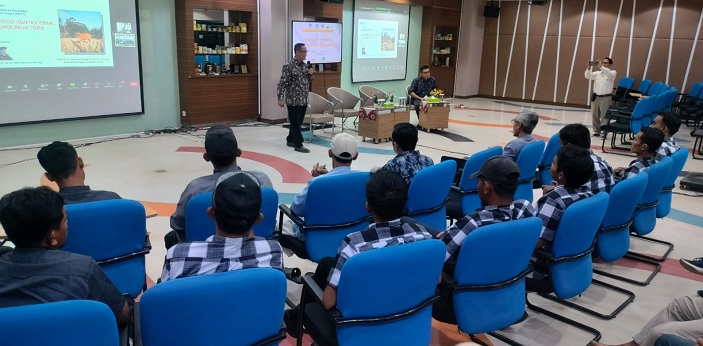PT Great Giant Livestock (PT GGL) . This activity involved giving a Professional Public Lecture and Guest Lecture on the Veterinary Physiology I Course with speakers from IPB, namely Prof. Dr. drh. Agik Suprayogi, and Veterinarian Coordination Great Giant Livestock Dep. Head of PT GGL, drh. Yunianto Eko Nugroho, on Saturday (18/11).
This public lecture is a form of transformation of learning outcomes and field experiences of practitioners and lecturers to students, not only IPB students, but also outside IPB, even involving IPB People’s Animal Husbandry School (SPR) breeders in 4 sub-districts in Central Lampung Regency. The theme of the Public Lecture is “Healthy and Productive Livestock Supporting Farmers’ Socioeconomics, Physiological Adaptation to Tropical Environments (Veterinary Physiology I).” This activity was attended offline by cattle breeders who are members of SPR and PT GGL partner farmers, as well as IPB students. Apart from that, the Public Lecture was also attended by students from Sriwijaya University Palembang, Jambi University, Gorontalo State University, and several other universities via a hybrid system via Zoom.
The activity was opened by the Deputy Dean for Academic and Student Affairs, School of Veterinary Medicine and Biomedicine, Bogor Agricultural Institute, namely Prof. Dr. drh. Ni Wayan Kurniani Karja, MP, Ph.D. Through the Zoom screen, Ni Wayan Kurniani Karja, expressed his gratitude for participating in the tokoreka program which not only contributes to creation and innovation to society but also involves students. “Thank you to the participants, I hope this activity will be useful for breeders in Lampung, especially those in Central Lampung and can spread throughout Indonesia,” he said.
Meanwhile, in his general lecture, Agik Suprayogi explained that the productivity and health of animals/livestock is closely related to the micro and macro environment. Livestock must be able to optimize their physiological adaptation conditions to the environment. “The optimal condition for livestock for optimum production is if the livestock is in a comfortable environment (Comfortable Zone). “Therefore, farmers must understand that if the cage environment is bad (humid, hot, muddy, strong odor, waste not managed), then production will be depressed and livestock health will be low,” he added.

